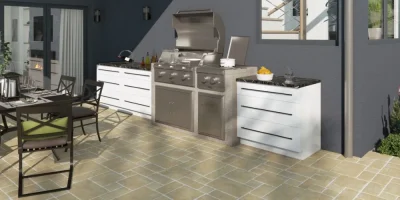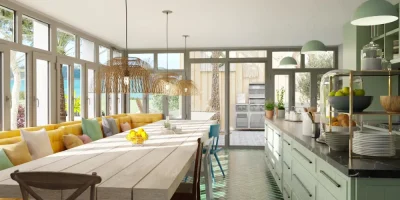Landscape design is like painting on nature’s canvas. It’s about turning your clients’ outdoor spaces into welcoming places where they can relax and enjoy time with friends and family.
If you’re fresh out of ideas for making that happen, check out this guide to help unlock your creativity. We’ll cover everything from helping your clients pick the perfect theme to ten ideas to incorporate into your designs. Plus, we’ll show you some pro tips for streamlining your landscape design process and landing more clients.
Let’s start with how to help your clients decide on a landscape theme.
First Things First, Decide On Your Landscape Theme
When starting a landscape design project, the first step is to decide on a theme. This sets the tone for the entire project and guides your design decisions. Here’s how to work with your clients to make this important decision.
Important! – Spend as much time as needed on this step. Sometimes clients aren’t sure yet what they want or need. So be ready to help guide them through this decision-making process.
Assess Their Preferences: Start by understanding your client’s style and preferences. For example, are they drawn to a modern, minimalist look or a lush, tropical oasis? Knowing their tastes will help you narrow down the options.
Consider the Environment: Consider the local climate, soil type, and existing vegetation. This will influence the suitability of certain themes and plant choices.
Budget and Maintenance: Discuss budget constraints and maintenance expectations. Some themes may be more cost-effective or easier to maintain than others.
Site Analysis: Evaluate the layout of the outdoor space. Does it have any unique features, such as slopes or existing structures? Try to incorporate these into the theme.
PRO TIP! – Verbally communicating design ideas can lead to misunderstandings and unhappy clients. That’s why professional landscape designers should use 3D design software like Cedreo. With 3D renderings, you can show rather than just explain your ideas. This helps clients visualize the final result and give better design feedback. But what if you don’t have any 3D design experience? Cedreo’s intuitive software takes care of the heavy lifting so you can get pro-level renderings even if you’re a new designer.
By guiding your clients through these considerations, you’ll help them make an informed choice that sets the stage for a stunning landscape design.
10 Landscape Ideas to Elevate Any Design Proposal
Now that you’ve helped your clients decide on a theme, let’s dive into ten landscape ideas that can transform their outdoor space into a work of art.
1. Plant at varying levels
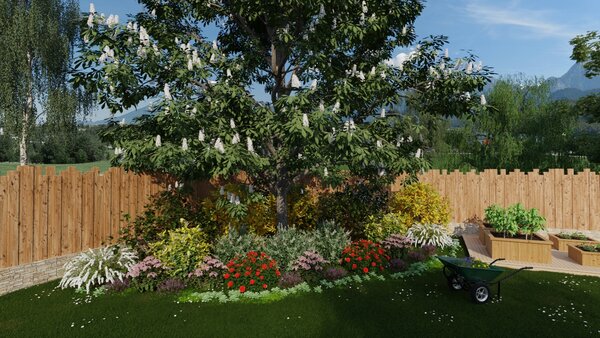
To infuse your landscape with depth and variety, consider planting at different elevations. Blend groundcovers, shrubs, and trees to create layers of vegetation, forming a dynamic and captivating landscape. This multi-level approach not only adds depth but also enhances the overall visual appeal.
2. Mix Fruit, Vegetable, and Flowering Plants in raised beds
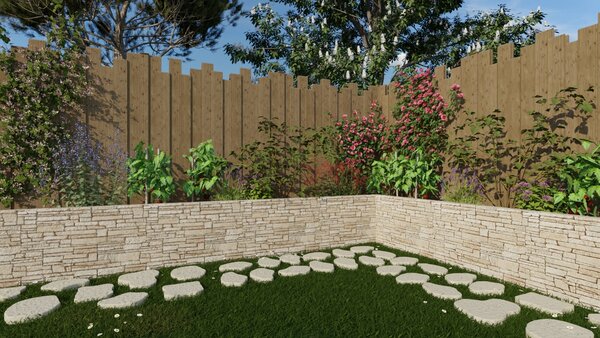
Create raised beds that combine both useful and beautiful elements by planting a mix of edible and ornamental plants. This practical yet visually appealing approach lets you grow fresh produce while adding vibrant colors and textures to your landscape.
3. Upgrade sheds or other structures with flowering roof
Look for ways to make use of existing structures on the property. A cool way to freshen them up is with a flowering green roof. Succulents and wildflowers make great choices for roofs like these. This innovative approach turns ordinary structures into statement pieces by drawing attention upward and creating a charming aesthetic.
4. Create an outdoor conversation pit
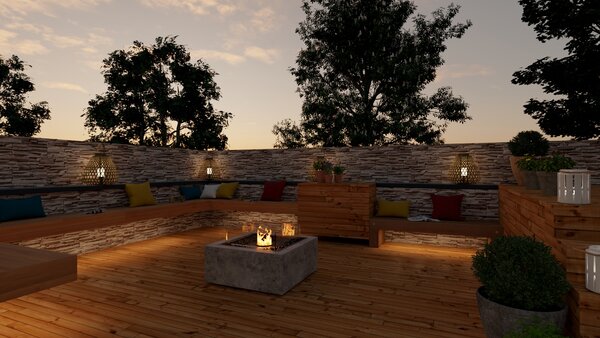
Elevate the social aspect of your client’s outdoor space by including a sunken conversation pit. This intimate seating area encourages gatherings and fosters memorable moments with family and friends. Surround it with lush vegetation or cozy furnishings for an inviting ambiance. Or add a projector screen for epic movie nights.
5. Explore adding different tiles to outdoor elements
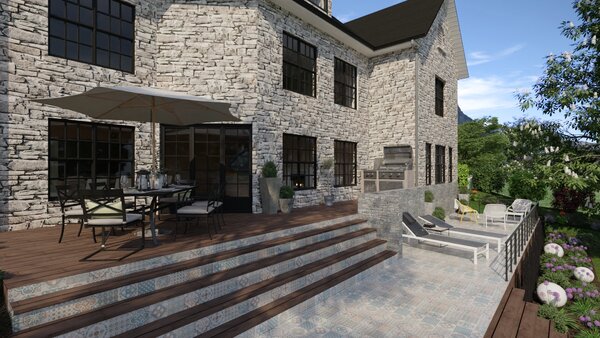
Ditch the conventional materials and opt for distinctive tiles to revamp outdoor elements. Whether it’s the pathway, patio, or even a mosaic tabletop, unique tiles introduce a burst of color and personality. These areas then become statement pieces within the landscape.
6. Incorporate hanging flowers to draw the eyes up
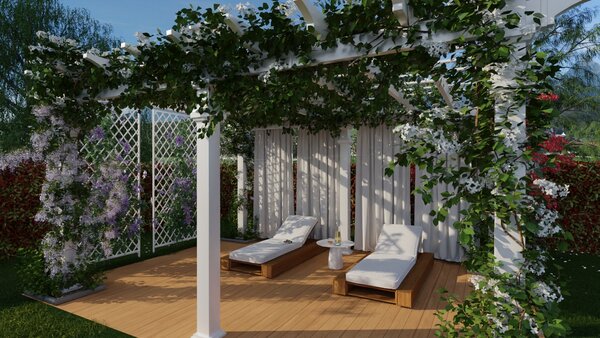
Take full advantage of the vertical dimension by adding hanging flower baskets or vertical gardens to your landscape design. These suspended gardens not only maximize space but also serve as attention-grabbing features that draw the eyes upward.
7. Soften slopes with grass steps
Try transforming sloped yards into functional and appealing areas by installing grass steps or terraces. This innovative approach enhances accessibility, prevents soil erosion and gives the yard more useable space.
8. Bring water elements to your design with ponds and fountains
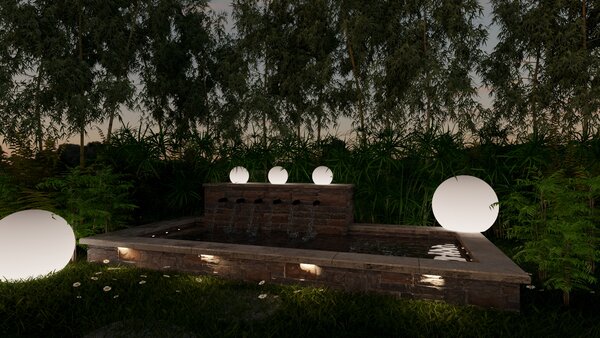
Elevate the serenity of your client’s landscape by incorporating water features like ponds and fountains. The soothing sounds of flowing water create a tranquil atmosphere while introducing a touch of luxury. While they do add focal points, keep in mind that they often require extra maintenance.
9. Separate areas with different types of flooring
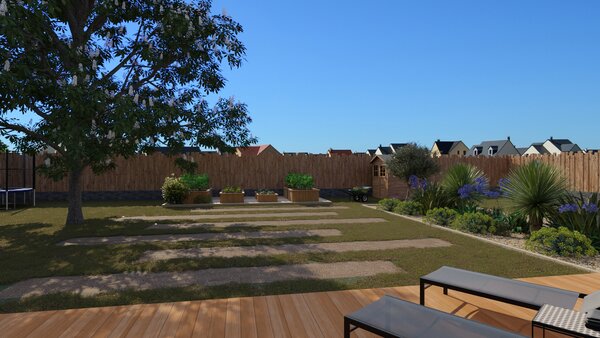
Define distinct functional areas within your landscape by utilizing different types of flooring materials. For example, use pavers for dining spaces and gravel for garden paths. This separation not only adds practicality but also enhances the aesthetic diversity of the landscape.
10. Add a touch of luxury with an in-ground hot tub
Take outdoor relaxation to the next level by integrating an in-ground hot tub. This luxurious addition provides a haven for unwinding and rejuvenation. Surround it with lush greenery or elegant landscaping to create a private oasis.
Ready to bring your landscape ideas to life on your next project? Why not harness the power of Cedreo software to streamline your design process?
With Cedreo home design software you get:
- Extensive Design Library: Access 1,000s of plants, shrubs, trees, customizable hardscape elements and more.
- 3D Visualization: Bring designs to life with stunning 3D renderings.
- User-Friendly Interface: Streamline your workflow with intelligent tools that do the hard work for you.
- Team Collaboration: Cloud software lets you and your team access designs from anywhere.
With a FREE version, you’ve got nothing to lose. Sign up for Cedreo today and see what it can do for your next landscape design.


